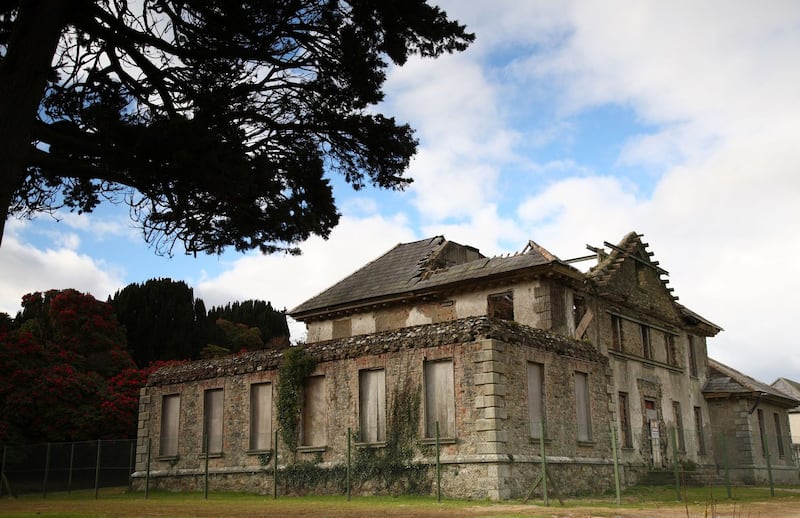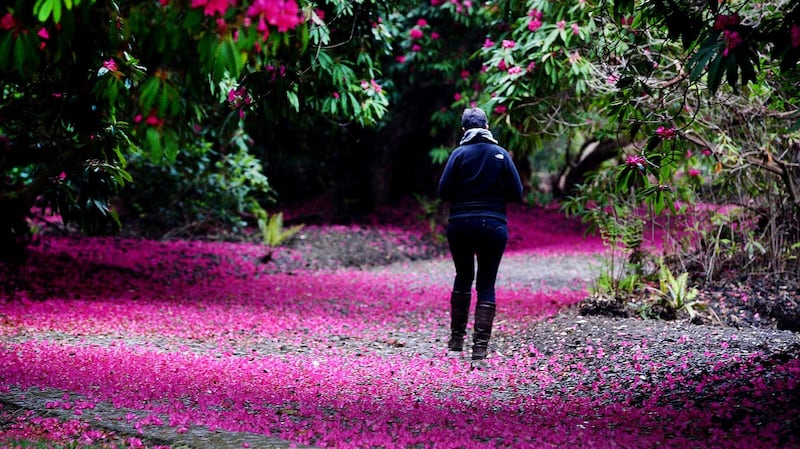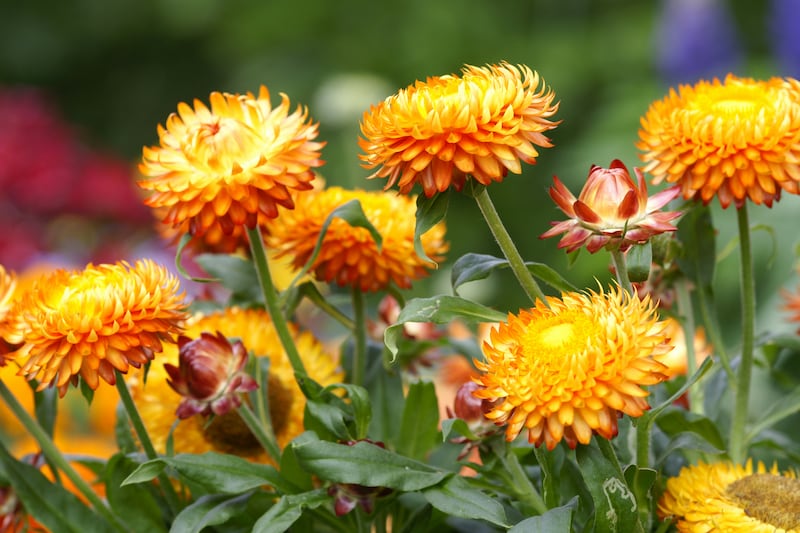Visiting any garden after the endless nothingness of lockdown number three feels strange. But visiting Kilmacurragh National Botanic Gardens in east Wicklow at this time of year feels surreal, as if you've been abruptly catapulted into some kind of psychedelic dreamworld filled with the liquid trill of birdsong and groves of giant rhododendrons dripping with Jack in the Beanstalk-sized scarlet blossoms.
One of Ireland’s most atmospheric gardens, it’s a place of secret woodland glades, wildflower meadows, stone follies, trickling water rills, herbaceous borders and sun-warmed lawns studded with ghostly narcissi, fritillaries and wood anemones, where wild violets bloom beneath the shade of ancient trees and monkey-puzzle trees stand sentry on the distant hills.
Even Kilmacurragh House itself – a picturesque late-seventeenth century ruin populated by garrulous rooks – looks like something from a Mervyn Peake drawing, its crumbling old walls exotically fringed with the giant, leafy rosettes of self-sown echiums (Echium pininana).

From the very late 1600s until the 1920s the house was home to successive generations of the Acton family, who've left their mark upon its gardens and demesne in a myriad of ways. The line of centuries-old lime trees (Tilia x Europea Zwarte Linde) that grow right next to Kilmacurragh's walled garden, for example, were planted in the early 1700s to mark the marriage of William and Jane Acton.
That same 2-acre walled garden, once home to an orangerie and lean-to glasshouses heated by an elaborate system of flues that run through its high brick walls, was built in the very early 1800s by the couple’s grandson Thomas. It was the latter’s eldest son (also called Thomas Acton) and their daughter Jane Acton who in the nineteenth century together did so much to shape Kilmacurragh’s gardens as visitors see them today.
Treasures
Passionate plantspeople, they swept away much of its more formal Dutch-style elements and filled it with horticultural treasures gathered during their travels abroad, bought from leading nurseries or given to them by David Moore, the then-curator of the National Botanic Gardens in Glasnevin and his son and successor Sir Frederick Moore.
Those treasures included many kinds of choice rhododendrons,unusual southern hemisphere conifers and calcifuges that thrive in Kilmacurragh’s deep, acidic soil and mild microclimate. Many were grown from plant material originally collected in the wild by some of the most noted botanists, plant hunters and adventurers of the day.
Managed by OPW since 1996, since 2006 the historic gardens and demesne have been in the charge of their Wicklow-born OPW head-gardener and curator, the horticulturist, author and plant-hunter Seamus O'Brien, under whose exceptional care they've blossomed. Last year OPW commissioner John McMahon negotiated a deal to purchase Kilmacurragh's Regency walled garden plus a further 53 adjoining acres that had belonged to the estate but had been in the separate ownership of Coillte since the mid-1970s.

O’Brien, whose boundless interest in the history of Kilmacurragh equals his deep passion for its gardens, is almost giddy with excitement at the possibilities that this deeply symbolic reunification of Kilmacurragh’s historic landscape has opened up.
He and his small team of gardeners and GOs are already hard at work restoring those recovered acres, clearing away decades of overgrowth and instating new pathways. In preparation for replanting, they're propagating thousands of young plants from seed, many of which O'Brien collected in Ireland as well as on his plant-hunting expeditions to China, Taiwan, Chile and Tasmania.
Just before Brexit hit, he contacted some of the UK's historic gardens including The Royal Botanic Gardens Edinburgh and its best specialist nurseries including Glendoick, Burncoose, Loder, Trehane and Millais to source a new generation of choice plants that will add to Kilmacurragh's already exceptional collection.
"The aim is to conserve and build on that existing historic collection but also add the very best of the newer plant introductions including some wonderful varieties of Magnolia campbelli and Magnolia dawsoniana, camellias and new rhododendrons such as the large-leaved Rhododendron kesangiae, a very rare species named after the queen grandmother of Bhutan. I can't wait to get them in the ground," O'Brien says.
Restoration
Other important additions to the collection are coming from historic Irish gardens and nurseries including Mount Congreve, Ballywalter Park, Seaforde and Mount Stewart.
Dozens of these baby plants are already tucked into a temporary nursery bed in the garden until their permanent planting positions are ready for them. O’Brien has also begun the process of removing the commercial polytunnels, multispan glasshouses and other modern structures that filled the walled garden during Coillte’s tenure, clearing away decades of overgrowth and starting the process of restoring the radically-altered soil levels to their original, gentle south-facing slope.
Over the next few years, its original system of formal paths will be re-instated, its old walls repaired and its fruit orchard re-planted while he can't wait to fill its borders with lots and lots of gloriously scented varieties of old roses such as Ispahan and Rosa Mundi.
Very little of Kilmacurragh walled garden's historic planting has survived but what has is of special significance. It includes a venerable specimen of Magnolia campbelli that came to Kilmacurragh from Darjeeling via Calcutta in 1876, travelling part of its journey by boat in a Wardian case (a favourite contraption of Victorian plant collectors similar to a terrarium, it helped to keep choice specimens alive while in transit).
Trained as an espalier as a young plant, it's grown so huge over the ensuing years that it's damaged a section of the garden's old brick wall, which will now have to be rebuilt. Another is the specimen of Antarctic beech (Nothofagus moorei) which O'Brien proudly points out is the first in the world to be successfully grown outside of Australia.
Last, but certainly not least, are the three gangly, almost intertwined gingko trees that have stood in the same spot in Kilmacurragh’s walled garden since 1914 when their gardeners ‘temporarily’ footed them into the ground before heading off to fight in the first World War. A poignant symbol of this historic Irish garden’s long history of cultivation and its capacity to endure, they’ll be staying exactly where they are.
The National Botanic Gardens Kilmacurragh is open to the public all year round with free admission. For directions and details of opening hours, see botanicgardens.ie.

This Week in the Garden
Plants growing in unventilated polytunnels, glasshouses and cold frames can be exposed to great extremes of temperature at this time of year, which can stress and even kill them. So it’s important to open doors, vents and windows first thing on bright sunny days but close them again in the evening as temperatures start to fall.
In particular keep a very careful eye on pots and trays of young seedlings and transplants, which will need to be regularly watered and protected from high temperatures and sharp frosts until the time comes to plant them into their permanent positions.
Many different kinds of half-hardy flowering annuals can be sown under cover at this time of year for planting outside in late May to provide a welcome splash of colour in the summer garden and to use as cut-flowers for the home.
Examples include varieties of cosmos, strawflower (Helichrysum bracteatum), amaranthus, tagetes, nicotiana and Verbena x hybrida. Recommended seed suppliers include all good garden centres, mrmiddleton.com and seedaholic.com.











